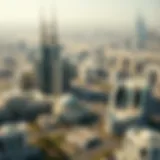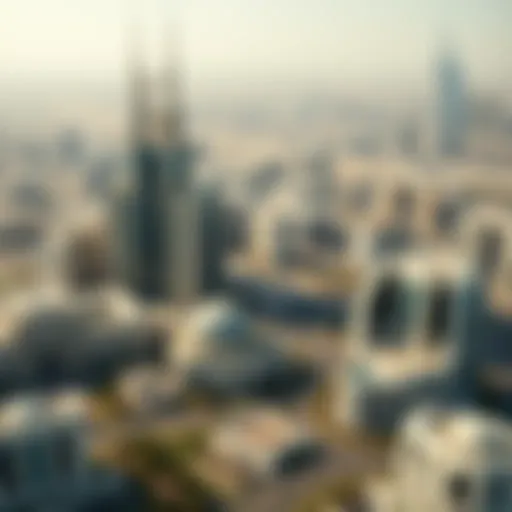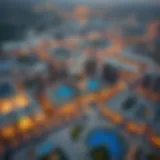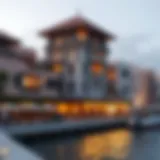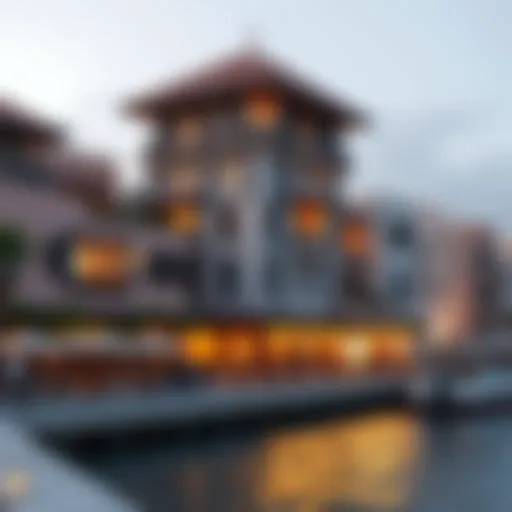Exploring the Red Line Stations of Dubai


Intro
The Red Line of Dubai's rapid transit system is not just a line on a map; it is a vital artery that keeps the city pulsing with energy and movement. Spanning the bustling heart of Dubai, it threads through some of the most significant neighborhoods and landmarks. As the city continues to grow and evolve, understanding this transit system is crucial for anyone interested in real estate, business, or urban development.
With each station acting as a hub for both local commuters and international visitors, the influence of the Dubai Metro Red Line stretches far beyond just transportation. It shapes real estate trends, ensures connectivity, and fosters urban growth. This article aims to provide an in-depth look at the Red Line stations, diving into their design, location advantages, and the ripple effects they create in the city's property market.
From investors looking to capitalize on emerging neighborhoods to homebuyers searching for accessible living spaces, the Red Line stations play a key role in navigating the ever-changing landscape of Dubai's real estate. By analyzing critical aspects, we will shed light on how these transit hubs inform decisions and shape the emirate’s development narrative.
Intro to Dubai's Metro System
Dubai's Metro system has become a cornerstone of the city's transportation landscape. This intricately planned network serves not only as a mode of transport but also as a catalyst for urban development and economic growth. The Red Line, in particular, stands out due to its strategic placement and significance in connecting various key districts within Dubai. The scope of discussion surrounding such a pivotal element cannot be overstated, as it intertwines deeply with the livelihoods of commuters and the overall vibrancy of the city.
Overview of the Metro Network
The Metro network in Dubai boasts two primary lines—the Red Line and the Green Line—extending over 75 kilometers combined. As one of the longest driverless metro systems in the world, it operates with remarkable efficiency, providing a seamless experience to millions each year. Stations are strategically positioned near major commercial hubs, residential areas, and landmarks, making it a practical choice for a diverse user base.
- The Red Line runs from Rashidiya in the east to Jebel Ali in the west. Along this route, it connects vital areas such as the Dubai Mall, Financial District, and several residential communities.
- The Green Line primarily caters to older neighborhoods and brings additional connectivity to the surrounding districts.
Beyond these lines, the network integrates with buses, taxis, and other modes of transit, bolstering interconnectivity and ensuring that mobility across the city is both comprehensive and user-friendly. Overall, Dubai’s Metro system epitomizes a modern urban transport approach, aligning with international standards while reflecting the unique needs of the emirate.
Importance of the Red Line
The Red Line holds particular sway in the grand narrative of Dubai's urban framework. Its introduction has not only revolutionized day-to-day commuting but has also reinforced the potential for substantial real estate growth across its trajectory. Several essential aspects contribute to its prominence:
- Economic Integration: The Red Line facilitates easy access to Dubai's business districts, enhancing economic activity. As employees, tourists, and residents frequent these zones, businesses flourish, creating a cycle of economic opportunities.
- Real Estate Development: The proximity of properties to Red Line stations brings about an increase in property values. Skyrocketing demand for residential and commercial spaces along these transit points signals a growing trend that prospective investors need to observe closely.
- Sustainable Urban Mobility: Emphasizing public transport systems like the Metro diminishes reliance on private vehicles, thus promoting a greener urban environment. This initiative dovetails with Dubai’s commitment towards sustainability, attracting a conscientious demographic.
The Red Line does not just transport passengers; it transports the very heartbeat of the city's dynamic growth.
In summary, while the Metro network in Dubai functions as a vital transport system, it is the Red Line that plays an unparalleled role in shaping the future of urban development and connectivity. Understanding its implications is essential for anyone keen on navigating the intricate currents of Dubai's ever-evolving landscape.
Key Red Line Stations
In this section, we delve into the pivotal stations along Dubai's Red Line, examining their crucial role in the metro system and urban development. Each station serves not just as a transit point but also plays a significant part in shaping the surrounding environment. Understanding these stations is vital for anyone keen on navigating the emirate's public transport or looking to invest in real estate.
Union Station
Location Details
Union Station stands as the main junction of the Dubai Metro. This station is strategically situated in the bustling heart of Dubai, connecting multiple lines. Its location is ideal for commuters as it links directly to the city’s major areas. One notable feature is the nearby access to main roadways and bus routes, making it a prime choice for travelers. This connectivity provides easy access to various districts, enhancing its importance in daily commutes.
Design Features
Architecturally, Union Station is a remarkable blend of modernity and functionality. The spacious design accommodates a heavy flow of passengers efficiently. Its sleek, contemporary look, paired with practical layout, makes navigating the station straightforward. However, during peak hours, the station can feel quite cramped, which is a downside for many users. Despite this, its design contributes significantly to the overall efficiency and aesthetic appeal of the metro system.
Deira City Centre Station
Accessibility Options
Deira City Centre Station is one of the more accessible stations on the Red Line. It boasts ramps, elevators, and well-marked signages, ensuring that everyone, including those with disabilities, can navigate it with ease. What sets it apart is its close proximity to shopping complexes, making it a favored spot for both locals and tourists. However, during busy shopping seasons, the influx of visitors can create congestion, posing challenges in accessibility at times.
Nearby Attractions
The station's vicinity features a mix of cultural and entertainment attractions. The Deira City Centre itself, being a prominent mall, offers a variety of retail outlets and dining options. Additionally, the nearby Al Ghurair Centre adds to the station's allure for shoppers and families alike. This combination of attractions elevates the importance of Deira City Centre Station within the metro framework, transforming it into more than just a transit point.
Burj Khalifa/Dubai Mall Station
Integration with Tourist Destinations
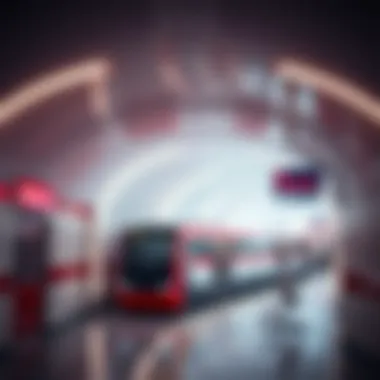

Burj Khalifa/Dubai Mall Station is uniquely positioned to serve visitors drawn to iconic landmarks. The seamless linkage to the Dubai Mall, the world's largest shopping destination, enhances its appeal as a tourist haven. The proximity to the Burj Khalifa further solidifies its status, with many tourists opting for the metro to avoid the hassle of traffic. However, it can get overrun with visitors, especially during weekends or holidays.
Impact on Property Values
Real estate dynamics around this station have seen a marked increase, largely driven by tourism and foot traffic. The presence of high-profile landmarks boosts property values, making it a prime investment location. High rises and luxury apartments in the vicinity benefit from the station’s popularity, though this leads to higher property prices, potentially placing them out of reach for average homebuyers seeking more affordable options.
Jebel Ali Station
Strategic Importance
Jebel Ali Station is pivotal for its role in supporting industrial and commercial areas in the region. This station service the Jebel Ali Free Zone, significantly enhancing logistics for businesses. Its strategic location allows it to facilitate not just passenger transit but also freight movement, making it essential for economic activities. However, the station’s layout could use improvements to better accommodate users during peak hours.
Regional Connectivity
Beyond its internal significance, Jebel Ali Station connects with other transport networks, which expands its regional accessibility. This makes it a vital link between metropolitan areas and suburban districts. The ability to easily transfer to bus networks strengthens its functionality, although it may also experience crowding, particularly during rush hours. Thus, while it offers enhanced connectivity for commuters, improvements may be necessary to manage the traffic flow effectively.
Connectivity Across the Red Line
The Red Line forms the backbone of Dubai's metro system, seamlessly connecting varied parts of the metropolis. It's not just about getting from point A to point B; the real value lies in its intricate web of connections that extends far beyond the train tracks. Understanding the connectivity across the Red Line is vital for discerning its impact on day-to-day commutes, business operations, and urban expansion.
Linkages to Other Transportation Systems
Integration with Bus Services
The integration of bus services with the Red Line stations is a standout feature that enhances the effectiveness of Dubai's transit system. Buses offer a crucial lifeline, whisking passengers from the metro stations to their final destinations, be it offices, shopping centers, or residential areas. A key characteristic of this integration is the way it provides a comprehensive urban transport solution, addressing the need for last-mile connectivity.
In practice, many Red Line stations serve as hubs for multiple bus routes, ensuring that there’s a bus waiting just around the corner. This connectivity is beneficial for everyday commuters who need reliability and ease when switching from train to bus.
Yet, it's not without its quirks. For instance, during peak hours, one might find the buses filling quickly, potentially leaving some passengers in a lurch. Overall, this integration promotes a smoother transit experience, aiding both residents and visitors to navigate the ever-bustling city.
Future Developments
As Dubai continues to evolve, so does its transportation infrastructure. Future developments tied to the Red Line suggest ambitious expansion plans that will further solidify its role in urban connectivity. One key characteristic to note is the projected addition of new stations and extensions that will promote better access to developing neighborhoods on the city's periphery.
Planned developments indicate a clear intent to meet the growing demand for efficient public transport options as Dubai’s population swells. Unique features, such as potentially integrating light rail options with the metro, could lead to a transformative transit landscape.
Benefits abound but challenges can arise, too. For example, construction disruptions during upgrades may affect current travel patterns. However, these future developments are primarily geared towards enhancing overall connectivity, making them a focal point in discussions around urban planning.
Travel Times and Frequencies
Peak vs Off-Peak Schedules
Understanding travel times is essential for anyone considering using the Red Line. The discrepancy between peak and off-peak schedules notably impacts how effectively commuters can utilize the system. During peak hours, trains run more frequently, which helps alleviate congestion. However, the sheer volume of passengers can lead to crowded conditions inside the carriages, somewhat detracting from comfort. On the other hand, off-peak schedules create a more relaxed atmosphere, but with longer wait times. This dual nature of the service presents an interesting dynamic for those who can choose when to travel.
Commuting Strategies
Having an efficient commuting strategy can make all the difference when traveling via the Red Line. One strategy that frequently emerges is timing travel to coincide with off-peak hours to avoid the crush of commuters. Another popular tactic is combining metro travel with ridesharing services to enhance convenience and reduce overall travel time. Keep in mind, the robust nature of the Red Line means that commuters can enjoy flexibility, allowing them to adapt their strategies based on personal schedules and needs. This adaptability not only improves individual experiences, but it also has broader implications for urban mobility as a whole.
Effective planning around the Red Line can significantly enhance the commuting experience, making it less about the journey and more about the destination.
In summary, connectivity across the Red Line is crucial not just for navigating Dubai but for understanding the fabric of urban life here. From integration with bus services to navigating peak and off-peak schedules, each element plays a specific role in shaping overall transit experiences.
Real Estate Implications of the Red Line
The Red Line of Dubai's metro system isn't just a convenient means of transportation; it serves as a linchpin in the city's ever-evolving real estate market. Understanding the implications of the Red Line on real estate is crucial for anyone interested in investing in property in this bustling emirate. The stations along the route do not merely facilitate travel; they also enhance property value, create investment opportunities, and influence future urban development.
Property Prices Near Red Line Stations
Market Trends Overview
One cannot overstate the significance of property prices surrounding Red Line stations. The proximity to these transit hubs often results in higher demand for residential and commercial properties. Recent market trends reveal a consistent upward trajectory in prices near the stations, mainly due to the convenience and accessibility offered by the metro service. Listing prices near stations like the Burj Khalifa/Dubai Mall are typically above average, with buyers willing to pay a premium for the ease of travel.
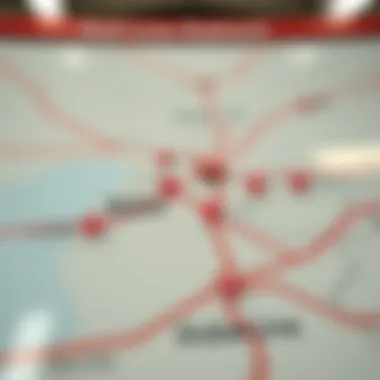

Another essential characteristic is the demographic that these areas attract. Young professionals and families increasingly find appealing living spaces near public transit, making these properties highly desirable. One unique feature of this dynamic is how it results in hybrid spaces where retail and living converge. However, potential investors should be wary; fluctuations can occur based on broader economic conditions.
Comparative Analysis of Areas
In examining comparative analysis of various areas along the Red Line, it's evident that not all stations hold the same real estate appeal. For instance, properties around the Union Station tend to exhibit different price structures compared to those near Jebel Ali. High foot traffic and connectivity at certain stations drive prices skyward, while others may lag behind.
This disparity encourages investors to consider location strategically. Emerging neighborhoods tend to offer lower entry points for property investors, yet the potential for appreciation in these locations presents a compelling case. A critical factor is how local amenities and future developments influence buying decisions. However, prospective investors must dig deep into the locality’s development plans to gauge the potential return on investment reliably.
Development Opportunities
Emerging Neighborhoods
Emerging neighborhoods linked to the Red Line represent a fertile ground for development opportunities. As infrastructure expands, districts previously considered peripheral are transforming into vibrant communities. Areas surrounding stations like Deira City Centre are experiencing gentrification, bringing in fresh life and innovation.
These neighborhoods are particularly attractive because they often come with lower property prices when compared to more established districts. However, the key ingredient for success in these locales is understanding the demographic shifts taking place and aligning investment strategies accordingly.
Strategic Investments
Strategic investments near Red Line stations can offer significant returns over the long haul. Properties that are not immediate revenue-generators can become highly valuable as the area develops. It is crucial for investors to keep an eye on upcoming public and private developments that promise to raise the profile of neighborhoods, such as commercial centers or parks.
Moreover, areas with ongoing urban renewal projects tend to see rapid increases in property values. But investors need to be mindful; high volatility can also be a double-edged sword. Timing and information are critical components in making the most of these strategic opportunities.
"Proximity to the Red Line is often a key indicator of potential property appreciation in Dubai."
Thus, prospective buyers and investors should pay close attention to the ongoing dynamics associated with the Red Line. Each station tells a different story, and understanding these nuances can spell the difference between a wise investment and a missed opportunity.
Challenges and Considerations
The Red Line stations of Dubai, while being pivotal to the city's transit system, also come with a set of challenges that must be acknowledged. Recognizing these difficulties can turn attention to potential solutions, directly influencing the user experience and the larger operational framework. Understanding both operational challenges and environmental concerns is crucial for those interested in the Red Line's role within the city's context.
Operational Challenges
Maintenance Issues
One major aspect of maintenance issues is the need for regular inspections and repairs of the trains and infrastructure. The daily wear and tear from countless commuters can lead to unexpected breakdowns, potentially inconveniencing thousands of passengers. Timely maintenance ensures that all aspects of the system function smoothly, which not only supports rider safety but also enhances overall satisfaction. However, maintenance isn’t a one-time task; it requires a commitment of resources and personnel. With an increasing number of riders, the need for continuous improvement and maintenance escalates, turning it into a juggling act for the authorities. While effective maintenance keeps the metro running, it can divert funds that might otherwise be used for station enhancements or additional services.
- Routine inspections are essential to address wear and tear.
- Budget constraints can limit the scope of necessary repairs.
A unique feature of this challenge is how it influences public perception. If maintenance lapses lead to delays or accidents, the overall trust in the transit system diminishes, disincentivizing potential commuters.
Capacity Constraints
Capacity constraints present significant challenges, particularly during peak commuting hours. The Red Line serves as a lifeline for many Dubai residents, yet the existing capacity can sometimes fall short of demand. With urban expansion and population growth, the need for larger and more frequent trains grows. As a result, people often face overcrowded cars, which creates an uncomfortable experience and may deter new users from adopting the metro.
- Understanding the cyclical model of urban growth helps navigate these constraints.
- Planning for higher capacity takes foresight and coordination among stakeholders.
Moreover, the reliance on limited train services can be a double-edged sword. While an effective strategy to optimize existing resources exists, the imbalance may strain the current infrastructure, necessitating immediate upgrades that don’t always come at a low cost.
Environmental Concerns
Sustainability Efforts
Sustainability efforts around the Red Line focus on minimizing its environmental footprint. Renewable energy solutions and waste reduction initiatives are integral components within the public transport framework. Moreover, the metro’s operations reduce vehicular traffic, thereby contributing to cleaner air in Dubai. These efforts can embody the essence of green urban planning.
- Promoting eco-friendly infrastructure upgrades is not only beneficial but necessary.
- Public campaigns raise awareness about sustainable travel options.
The unique feature of these sustainability efforts highlights a commitment to creating a resilient environment in a quickly evolving city. However, implementing these measures can sometimes compete for resources with more pressing operational needs.


Noise and Pollution
Noise and pollution are inevitable byproducts of urbanization, and they present ongoing challenges, particularly in busy areas surrounding the Red Line. While the metro itself is designed to be more eco-friendly than other forms of transport, the construction and operation phases can still lead to local disturbances. The noise from increasing train traffic can contribute to rising unease among nearby residents, impacting their quality of life.
- Noise barriers and sound mitigation strategies are necessary to ease concerns.
- Engaging the local community in discussions helps facilitate better understanding.
Thus, integrating these considerations into planning processes poses not just a challenge, but an opportunity for developers and urban planners to create solutions that benefit everyone. As Dubai continues to establish its reputation as a leading metropolitan area, addressing these challenges seamlessly becomes crucial for balancing progress and livability.
Future of the Red Line and Urban Development
The future of the Red Line is not just a matter of transport; it’s a pivot around which urban development in Dubai is spinning. More than mere tracks and stations, these components of the Red Line represent opportunities for growth, innovation, and a communal lifestyle. As the population of Dubai continues to swell, so does the necessity for sustainable urban solutions. The Red Line is in the thick of this discourse, acting as a vital link that can reduce traffic congestion, enhance accessibility, and spur economic dynamism across the emirate.
Urban development is closely tied to the expansion and modernization of the metro system. As real estate markets pivot toward transit-oriented development, the Red Line stands to benefit from an increased demand in property values and commercial interests. Amid rapid urbanization, understanding the Red Line’s evolvement is critical for investors, planners, and residents alike—all of whom have a stake in how accessible the city will be down the line.
Expansion Plans
Proposed Station Additions
Proposed station additions along the Red Line are set to expand its reach even further. This initiative is crucial to support the growing population and its resulting travels. New potential stations may be positioned in high-demand areas currently underserved by public transport. For example, introducing a station in regions like Al Quoz could unlock new residential and commercial spaces.
The key characteristic of these potential additions is that they are strategically planned to enhance connectivity. This makes them a beneficial choice for urban developers looking to draw in investments. Such developments can lead to a vibrant amalgamation of work and living spaces, creating a community feel while addressing the urgent need for public transport.
However, it’s important to recognize the challenges these expansions can bring. Each additional station requires meticulous planning and resources. Infrastructure changes can disrupt existing community dynamics before long-term benefits are realized.
Timeline for Development
A clear timeline for development is essential in managing expectations regarding the expansions. There’s much speculation about when these proposed station additions might become reality. The urgency that underlies the timeline reflects the need for timely implementation as the city rapidly grows.
An outlined timeline allows stakeholders to align their plans, particularly in real estate. Developers can strategize their projects around the expected completion of these stations. Importantly, a well-established schedule can also keep the public in the loop, maintaining transparency about the metro's progress. Lack of communication, conversely, can cause unrest among commuters and businesses relying on the timely implementation of these transport improvements.
Integration with Smart City Initiatives
Digital Infrastructure
Digital infrastructure is fundamental for enhancing the Red Line's efficiency. Smart tools can enable smoother operations, monitor station performance, and ensure real-time data sharing with users. Innovative tech applications are becoming the engine that drives urban transport, making experiences better for commuters and encouraging usage of public transport.
By integrating cutting-edge technology, like mobile ticketing or contactless payment systems, the Red Line can elevate itself as a modern transport medium. The ability to track trains and receive real-time updates cultivates a user-friendly environment that attracts more passengers. Yet, the flip side is also notable: there’s a risk of digital systems being prone to failures that could cause service disruptions.
Future Transit Technologies
Future transit technologies, such as autonomous trains or enhanced AI applications, could revolutionize the way the Red Line operates. The potential for these advancements to create a safer, more efficient travel environment can’t be overstated. Adopting these technologies may streamline operations and offer a more cohesive travel experience for riders.
Encouraging innovative technologies also aligns with Dubai's ambition to be a pioneer in smart city initiatives—making it a model for others to follow. This, however, could also raise questions about costs and ongoing maintenance associated with advanced systems. With great potential comes significant investment, demanding careful consideration of budget allocations.
The evolution of the Red Line is more than transportation; it’s about transforming Dubai into an interconnected urban hub.
In summary, the future of the Red Line stations presents vast opportunities. Whether through expansion, integration with smart technologies, or focusing on sustainable development, there's a wealth of avenues to explore. The decision-makers and investors must deliberate carefully on these aspects to harness the full potential of this iconic metro line.
Epilogue
The exploration of the Red Line stations in Dubai emphasizes the intricate relationship between transit systems and urban development. As an essential artery of the city's public transport framework, the Red Line does more than just connect various locales; it fundamentally shapes the socio-economic fabric of Dubai.
Summary of Insights
Throughout this article, we dissected the Red Line's key stations, evaluated their unique design features, highlighted their accessibility, and assessed their contributions to the surrounding neighborhoods’ real estate dynamics. Each station has its own character, serving different demographics and purposes. From Union Station’s bustling activity to Burj Khalifa/Dubai Mall Station's charm, understanding these nuances provides investors and stakeholders with a clearer view of how location, design, and connectivity can translate into tangible opportunities.
This detailed examination reveals that the impact of the Red Line stretches far beyond mere convenience. The stations foster community engagement, promote tourism, and enhance property values, all while illustrating the urban transformation of Dubai.
The Significance of the Red Line in Dubai's Future
The future of the Red Line is pivotal in determining not only the efficiency of Dubai’s transportation system but also its responses to urban evolution. The planned expansions and integration with smart city initiatives hint at an exciting forward trajectory. As the city embraces technology and sustainability, the Red Line positions itself as a central player in these developments, illustrating how public transit can adapt and maintain relevance amidst the rapid pace of change.
By investing in better infrastructure and pushing for expansion, Dubai aims to ensure inclusivity and connectivity for all its residents and visitors. The Red Line is not merely a conduit for movement; it is a vital component of Dubai’s overarching narrative, facilitating growth, fostering neighborhoods, and connecting people. As such, stakeholders, be they investors, developers, or policy-makers, must pay heed to how the Red Line informs urban strategies and economic resilience moving forward.
"In the grand scheme, the Red Line is more than transport; it's the lifeline of Dubai’s future."




